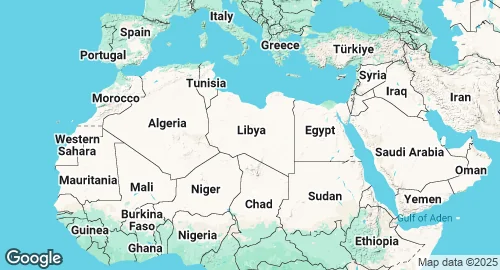Libya Military Forces 🇱🇾
Military Strength Overview
| 🛩️ Air Force | 141 active aircraft |
| 🪖 Active Troops | 32,000 personnels |
Defense Statistics & Key Metrics
| Population | 7.3 million (2023) |
| GDP | $45.1 billion (2023) |
| GDP per capita | $6173 (2023) |
| Military Budget | $1.6 billion (2023) |
| Share of GDP in Milex | 5.3% (2023) |
| Share of Govt Expenditures | 5.5% (2023) |
| Military spends per capita | $217 (2023) |
| Inflation Rate | 2.37% (2023) |
| Military Personnel | 7,000 (2013) |
Strategic Overview in 2025
Libya’s military strength is a collection of fragmented, rival forces aligned with two main political entities: the internationally recognized Government of National Unity (GNU) in Tripoli and the eastern-based House of Representatives, which backs Field Marshal Khalifa Haftar's Libyan National Army (LNA). The LNA, a more conventionally structured force, is a mix of regular units, tribal militias, and foreign mercenaries. In contrast, the forces aligned with the GNU are a loose coalition of city-based militias and armed groups with varying degrees of loyalty and coordination. This fundamental division makes a unified national military non-existent and defines the country's precarious security environment.
Equipment and Foreign Influence
Both factions are heavily reliant on foreign military support, which dictates their operational capabilities. The LNA receives substantial backing from the United Arab Emirates (UAE), Egypt, and Russia, providing it with armored vehicles, aircraft, and advanced air defense systems. Notably, recent parades have showcased newly acquired Russian Tor-M2 air defense systems, enhancing the LNA's capabilities against aerial threats. The LNA also fields legacy equipment from the Gaddafi era, including T-72 tanks and BMP infantry fighting vehicles.
The GNU's military support primarily comes from Turkey and Qatar. This has included armed drones, which were pivotal in repelling the LNA's 2019 Tripoli offensive, as well as air defense systems and training. The influx of foreign-supplied weaponry, including from Syria and Iraq, despite a UN arms embargo, has turned Libya into a testing ground for modern warfare technologies, from drones to electronic warfare systems.
Domestic Military Industry
Libya's domestic defense industry is nascent and largely inoperative in a strategic sense. Decades of sanctions and the subsequent civil war have crippled any significant production capabilities. There are some state-owned facilities under the Military Industrialisation Authority, but their focus has shifted towards civilian applications, such as manufacturing spare parts for industrial and oil sectors, and even cooking gas cylinders, in an effort to contribute to the national economy. There is no evidence of significant domestic production of advanced military hardware.
Strategic Trends
The primary strategic trend remains the geopolitical competition between regional powers, which fuels the internal conflict. Russia has been expanding its military footprint in the country, using airbases as logistical hubs for its operations in the Sahel, while Turkey maintains its influence in the west to secure its maritime and economic interests. The military balance is in a state of flux, with neither side currently capable of achieving a decisive victory. The 2020 ceasefire is largely holding, but the continued flow of arms and the presence of foreign forces create a high risk of renewed large-scale conflict.
Libyan Military Budget History
Population and Military Personnel Trends
GDP and Inflation Rate Trends
Military Expenditure: SIPRI Milex.
